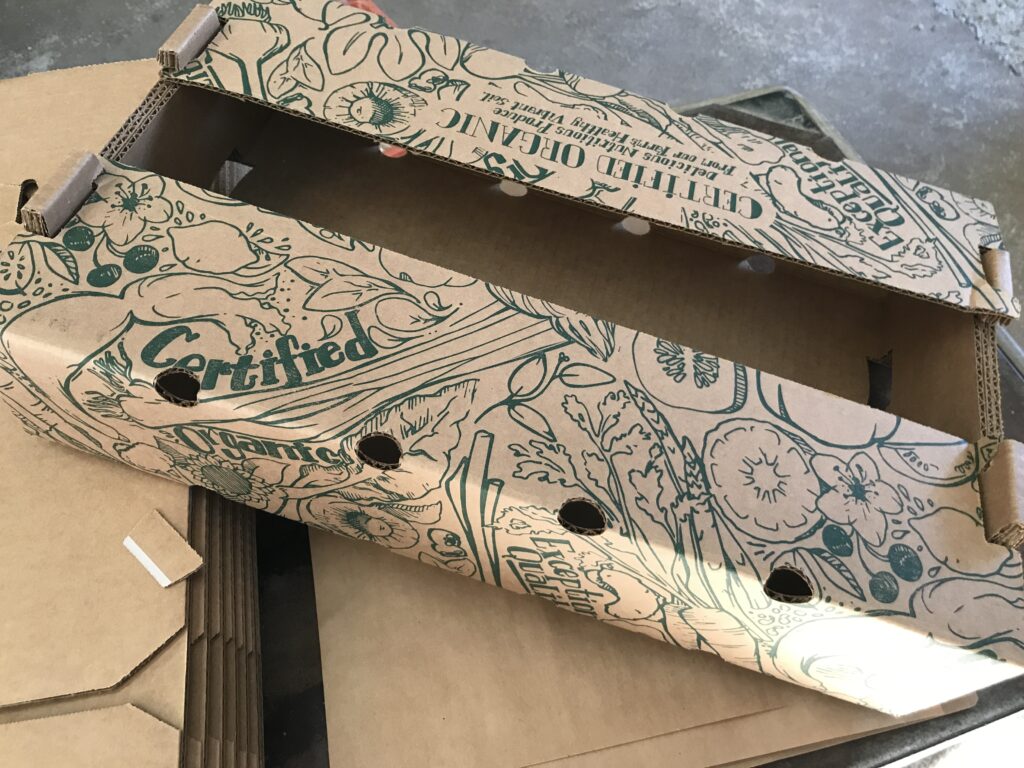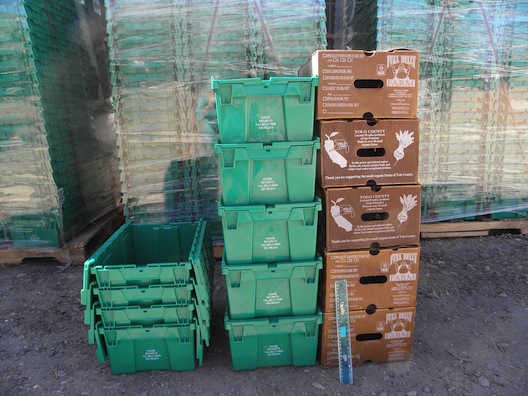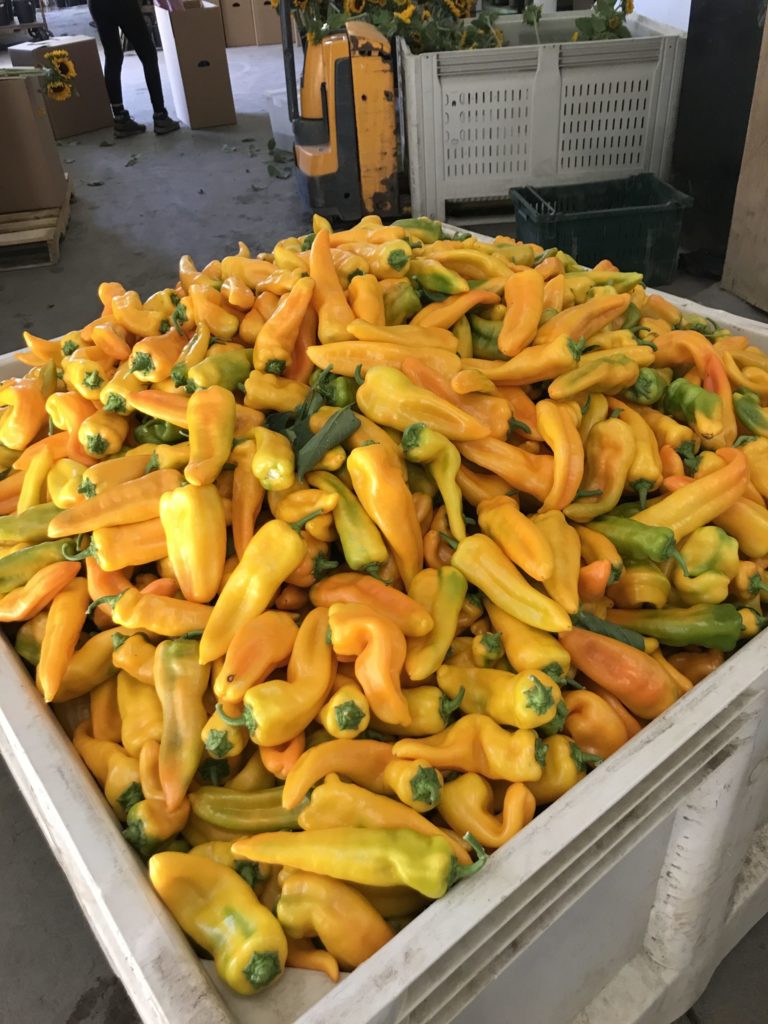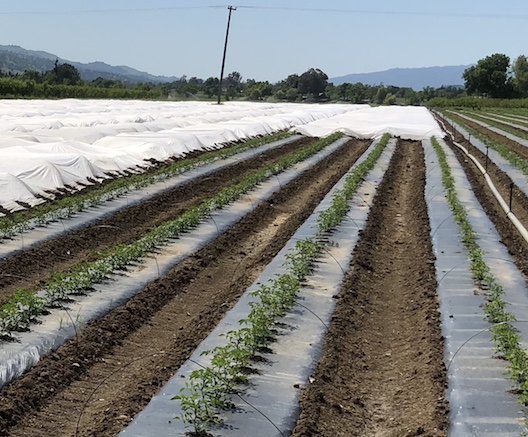There’s a regular rhythm to each day, though every day here is different, largely influenced by the time of year, and the day of the week. During the summer, everything is taken up a notch, not just the temperature. There is a lot of produce to water and harvest and only so many hours in the day to get it done. However those two Herculean tasks, tending to crops in the field and harvesting, are just part of what keeps us busy. A huge part of what we do is packing the produce, flowers, and other goods and then figuring out logistics to get everything on the correct truck so that everything arrives to its intended recipient. There’s no point in carefully growing great produce, and harvesting it at prime condition if it won’t get to you, or doesn’t arrive in good condition.
[Read more…]Theme: packing
News from the Farm | July 17, 2023

Last week’s deep dive into our plastic CSA boxes and wax boxes (which you can read, or reread, here) got pretty detailed, but I realized during the rest of the week that we’d barely scratched the surface when it comes to boxes and packaging. The Beet could probably focus on some aspect of packaging and post-harvest handling every week! But that would get boring pretty quickly. [Read more…]
News from the Farm | July 10, 2023

This week marks a CSA milestone: ten years ago, we stopped using waxed cardboard boxes for the CSA and started using the green plastic “Stop Waste” boxes*. We call them our “Stop Waste” boxes because the initial box purchase was aided by a grant from StopWaste. At the time of the switch, Judith wrote “this is a trial run” and since we’re still using them a decade later, it seems that the trial was a success. So this week, it’s a deep dive on boxes, accompanied by a smattering of vintage box photos from the past ten years. [Read more…]
News from the Farm | October 3, 2022

It looks like we’ve got one more week of weather in the 90s, but melon season has ended. It was a good season, running from early July to the end of September, about 16,300 CSA boxes with melons, many including two (small) melons!
With the transition from melons to winter squash, now is a great time to highlight and express our appreciation for the great work that the folks in the southern half of the shop do. Led by Valentin, this small but mighty crew are responsible for washing, sorting, and packing some our biggest crops in terms of volume, weight, and value: melons, winter squash, potatoes, carrots, and asparagus. They also bunch and cut broccoli, wash and bag oranges, bag onions, and sort and box corn. [Read more…]
News from the Farm | August 8, 2022

What do you do when you have a lot of hot peppers? If they’re hot because they’re spicy, we make hot sauce! If they’re hot in temperature, then we need to cool them down. The faster we can cool them down, the longer the shelf life and we want to get all of our peppers to our CSA members and other customers in the best condition possible. [Read more…]
News From the Farm | July 5, 2021
We keep reaching various milestones that make me think “well now it’s officially summer.” The first sungold cherry tomato, the first slice of watermelon, the first okra, the list goes on and on. In addition to all the great produce, summer for us means there’s even more to do. More to water, sell, harvest, sort, wash, pack, load, transport, and deliver. And we still need to plant and maintain fall crops so that we’ll have things to harvest when the summer crops (eventually) wind down.
News From the Farm | April 23, 2018
Many of you may have heard about the outbreak of disease related to romaine lettuce that has been traced to processing plants in Arizona. The US Centers for Disease Control and Prevention is warning people not to eat any form of romaine lettuce grown in the Yuma, Arizona area. Since the origin of greens, especially those that are pre-washed and bagged, is not easily identified, the CDC adds helpfully that you should throw out any romaine lettuce you might have if you don’t know where it came from. [Read more…]
News From the Farm | January 9, 2017
A note about our ‘Stop Waste’ boxes
Welcome back to Full Belly veggies! We hope that you had some wonderful meals during our holiday rest. We are excited to be your fruit and vegetable farmers for 2017. We appreciate all of you who are continuing members, as well as all of you who are trying out a Full Belly CSA box for the first time. We have had a lot of rain and some nice cold weather over the last few weeks, so our fields are muddy, slowing down the process of getting your veggies out of the field, to be washed, and packed. You may notice that the cold weather brings out the sweetness in our greens and carrots.
One of the chores of our winter break every year, is to collect and count our inventory of ‘Stop Waste’ CSA boxes. For our members who have been with us for awhile, the hard plastic green boxes that we pack your vegetables in, are old friends. We call them our Stop Waste boxes, because they are an alternative to the ubiquitous waxed cardboard boxes, usually used to pack produce, that go straight to the landfill after use. But the hard plastic boxes are expensive — we paid $12.25 for each one when we first purchased them in 2013, so we try to encourage all of our members, including those who get home delivered veggies, to make sure that all of the boxes are returned to the farm. [Read more…]
News From the Farm | November 16, 2015
Please Return Our Green ‘Stop Waste’ Boxes
Full Belly used to pack your CSA fruits and veggies into waxed cardboard boxes. Now we use the hard plastic, green ‘Stop Waste’ boxes. We made this change in late 2013 because although we were able to reuse the waxed cardboard boxes a few times, they had to go to the landfill once they started to break down. Because of the wax coating, they were not recyclable and without the wax coating they really didn’t hold up for more than one use. The hard plastic Stop Waste totes that we use now have proven extremely durable — we are not aware of even one box that has broken since they were purchased. That means that these boxes can be used over and over again.
Every week, for 48 weeks of the year, 1,100 families get a Full Belly CSA box. That’s a lot of boxes (52,000 — but who’s counting!) We calculate that more than 6 tons of cardboard waste are avoided every year as a result of replacing the waxed cardboard with the permanent hard plastic boxes. We used an Environmental Protection Agency Greenhouse Gas Emissions calculator and estimate that switching from waxed cardboard boxes to reusable plastic totes has resulted in an annual rate of greenhouse gas emission reductions of 34.1 tons. So the program is a success in many respects. [Read more…]
News From the Farm | Week of July 15, 2013
We hope that you like the new Stop Waste CSA Box that we have put into use this week! The goal of replacing the waxed cardboard boxes that we have been using is to eliminate the waste of sending them to the landfill.
Most produce is shipped from farms in single use containers. The predominant container is a waxed box, the wax being necessary because un-waxed boxes will not hold up stacked on a pallet when they are full of wet and iced produce. Waxed boxes cannot be recycled and are rarely composted. They generally end up in the landfill.
For farmers markets and many restaurants, Full Belly packs our boxes into permanent plastic totes, so why not do that for our CSA members as well? The trick will be that since every Stop Waste CSA Box is worth $12, every CSA member will have to return the box faithfully, but preferably leave it at their pick-up site. [Read more…]

